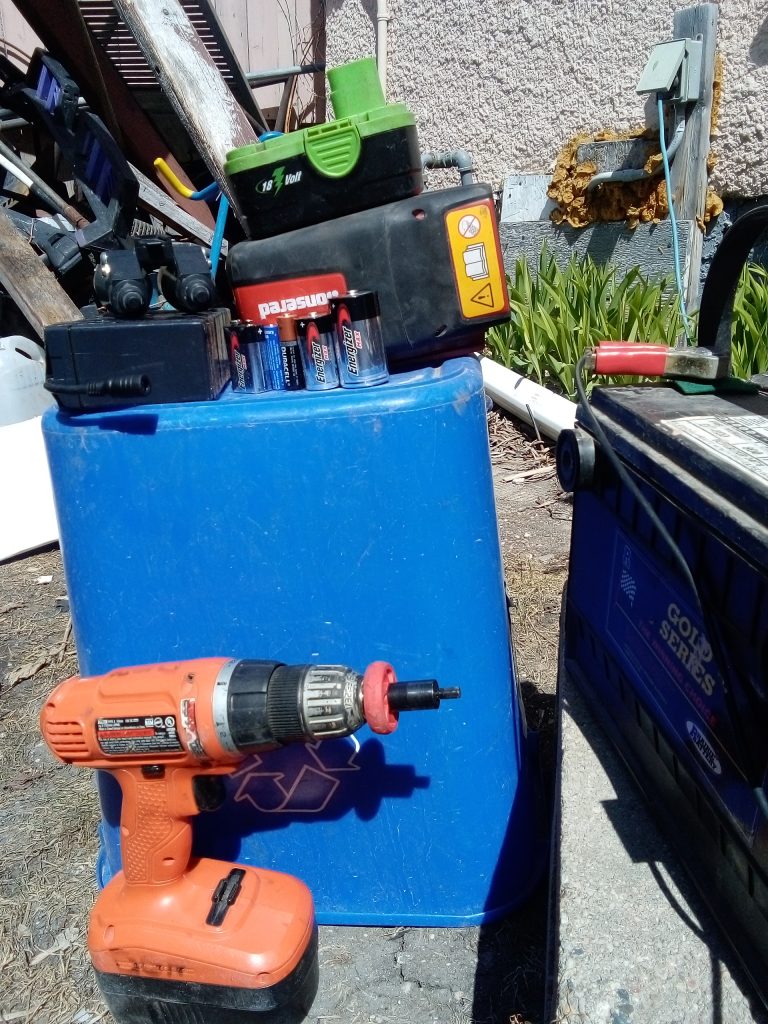Your robot will need some type of power to allow it to move or do anything. Your choice of the type of robot or its weight etc will dictate the type of power you use be it DC (battery) or AC (plug into the wall).
We could also later discuss alternative fuels or power sources like solar, hydrogen etc.
Now we will soon try to explain battery basics and some of the terminology thrown around with regards to batteries because this topic can get complicated in a hurry.
We all have used batteries in everything from our watches and cellphones to our portable radios and even cars.
Battery terms are plentiful with terms thrown around like alkaline or non alkaline, nicad versus nihi and the newer lithium versus lithium ion versus lithium polymer (LiPo) batteries and the various rechargeable types of batteries.
Companies like Tesla are making the news every few months because they are constantly working on ways to make a better long lasting and faster charging battery for their automobiles.
We have had talk in the last few years of a new type of battery called a solid state battery but we have yet to have them come into the commercial area.

Today’s smaller toy robots are using some type of rechargeable battery, usually a lithium polymer or ( LiPo) battery or lithium ion or simply a nicad off the shelf store batterie which we will describe soon.
Larger robotic devices like industrial robot arms in a factory are usually plugged into the wall and are most likely directly wired into a 220 volt circuit instead of a less powered 110 volt circuit found in most North American homes and offices.
Some warehouse robots that need to move around will have one or more banks of rechargeable larger batteries in their rolling bases.
The small home vacuum robots are like simple autonomous robots and have been intelligent enough in the last few years to automatically return to their base units to recharge themselves. This self recharging feature is also seen in many newer robot toys like the Vector toy robot and many others like it.
The kinds of batteries we use in our toy robots are older Nickel Cadmium or the more common, Nickel Hidride (NiH) or rechargeable batteries. NiH have about 50% more capacity and don’t have the toxicity of cadmium found in Nickel Cadmium batteries.

Most household batteries for flashlights and small toy robots are round 1.5 volts alkaline batteries except the rectangular ones which are 9 volts and are known by names like type AA, AAA, C, D or the tiny round coin size hearing aid batteries.
Lets talk a little bit now about some of the theory of batteries and the types to choose from.
All batteries are about electrons flowing from one terminal called the cathode to the other terminal called the anode and there is some liquid or gel or solid in the middle called the electrolyte.
Some lithium batteries got bad publicity a few years back because of how they are designed and the fact that some of them caught fire and were thus not allowed to be carried on airplanes and transported without having special labels on the packages.
This had to do with the eroding of one of the terminals and shorting out the circuit and causing a fire.
So even to this day many old school robot builders are going with old fashioned batteries for their initial builds and then converting to some form of a lithium battery solution.
The newer type of solid state batteries basically have a solid between the terminals instead of a liquid electrolyte.
Now there are two types of batteries Primary (non rechargeable) and secondary (rechargeable).
If we go back a few dozen years, ever since the first discovery of batteries, there was talk of wet cell and later dry cell batteries.
All electric batteries basically involved two parts: the two metal electrodes and the liquid electrolyte that the electrodes sat inside.
Originally the battery unit was not sealed but later it was sealed to make it easier to move batteries around with the units that needed them.
The larger heavy rechargeable 12 volt lead acid battery is the modern day battery that we became familiar with in our cars.
It is a sealed unit where there are two electrical anode posts in a liquid or gel.
One anode was a lead anode and the other anode was a lead dioxide cathode and they were placed inside of an electrolyte solution of sulphuric acid.
The acid would eat away at both anodes and produces lead sulfate which would go towards one anode and cause the current to travel between the two anodes.
These batteries can be recharged by reversing the direction of this process.
Smaller and lighter alkaline batteries became widely used and at first they were nickel cadmium and were called dry cells which did not need maintenance.
Nickel hydride came along and was less toxic and is what we have today.
Now the word alkaline is hard to explain but the alkaline battery has a non acidic electrolyte while the non alkaline batteries have an acidic electrolyte.
Some home robot makers have used 12 volt car batteries and golf cart 6 volt batteries and rv camper deep cycle batteries to power various parts of a robot device although most small robots use a handful of low power 1.5 volt batteries or lithium batteries to operate their servos.
Eventually lithium ion batteries came out and we have had about 6 various types including lithium with Cobalt and lithium with manganese and NMC or lithium Nickel manganese cobalt.
Lithium is the lightest weight metal.
There are two main types of lithium battery…the original lithium battery which is not rechargeable and the lithium ion battery which is rechargeable.
Most cell phones have small lithium batteries in them.
Most battery powered lawn mowers and related equipment these days are powered by 40 or 60 or 80 volt lithium batteries.
In 1997 the lithium polymer or simply LiPo battery was invented and its electrodes sit in a dry electrolyte.
There has even been talk of using solid state batteries which do not contain any gel or liquid in which case do not have any toxic danger or fire risk associated with some lithium batteries.
Types of DC batteries
Lithium Ion and Lipo
Why do the lawn mower companies release a different power battery each year?
First was 18 Volts, and then 40, 58, 60, 80 and could you use any of them for robot projects?
Yes there are several internet advanced hobbyists robot makers who made full size heavy humanoid robots by using actual modified 20 volt power screwdrivers as leg actuators (to make the knee joints move for walking).
For example the amazing XRobot maker, James Bruton had used battery powered screwdrivers in the legs of his robot.
Most heavy hobbyist robots are made to use ac (plug into the wall power) which of course totally limits its range.
Now with cars there has been a great deal of effort to produce the longest lasting battery that will charge the fastest. This is not just due to customer demands but it is largely due to the governments push to achieve the green movement goals.
Daimler Chrysler plans to focus on 100 percent battery /electric vehicles until 2025 and then between 2025 and 2035 they want to go with both battery electric and fuel cell vehicles.
Fuel cells will create electricity using hydrogen and of course larger vehciles are a great challenge due to their huge weight and extensive daily usage and often times huge distance requirements.